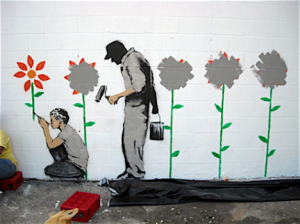 Banksy’s portrayal of the Gray Ghost.
Banksy’s portrayal of the Gray Ghost.
Graffiti is a very clear form of expression for an individual/group in order to identify themselves and what they believe/think/want etc. in a public manner. An article by Scott-Warren (365: 2010) says that: “[…] today’s graffiti is “a celebration of self. It’s, like, this is me, Claw, this is my name, this is my art, this is me, me, me. It’s a me thing and it’s my identity, this is who I am and it’s a total representation of me.””
The famous England based graffiti artist known as Banksy spent some time in New Orleans in 2008, to ‘do battle’ with a man known as the Gray Ghost – a good-to-do citizen who was (and still is) trying to keep the streets ‘clean’ of graffiti by painting over them with his signature gray paint.
The works by Banksy are well-liked and regarded as socio-political art representing freedom of expression/speech, yet this Gray Ghost viewed them purely as a form of vandalism that needed to be ‘cleaned up’, prompting calls from those who oppose him, saying he is causing more harm than good by actually suppressing freedom of expression, a basic right, simply because it comes in the form of graffiti. What the Gray Ghost is doing, though rather unwittingly, is not only calling attention to graffiti as freedom of expression, but adding his own personal expression in the form of his style of ‘graffiti’ by painting over other peoples’ works; he is saying “I don’t like this, mine is better. This is what I think”.
References
Scott-Warren, Jason. “Reading Graffiti in the Early Modern Book.” Huntington Library Quarterly Vol. 73, No. 3 (September 2010), pp. 363-381. Published by: University of California Press.
Web Urbanist: Local Designs to Global Destinations. “Banksy vs. The Gray Ghost in New Orleans.”
http://www.banksy.co.uk/
Alexandra Logan
